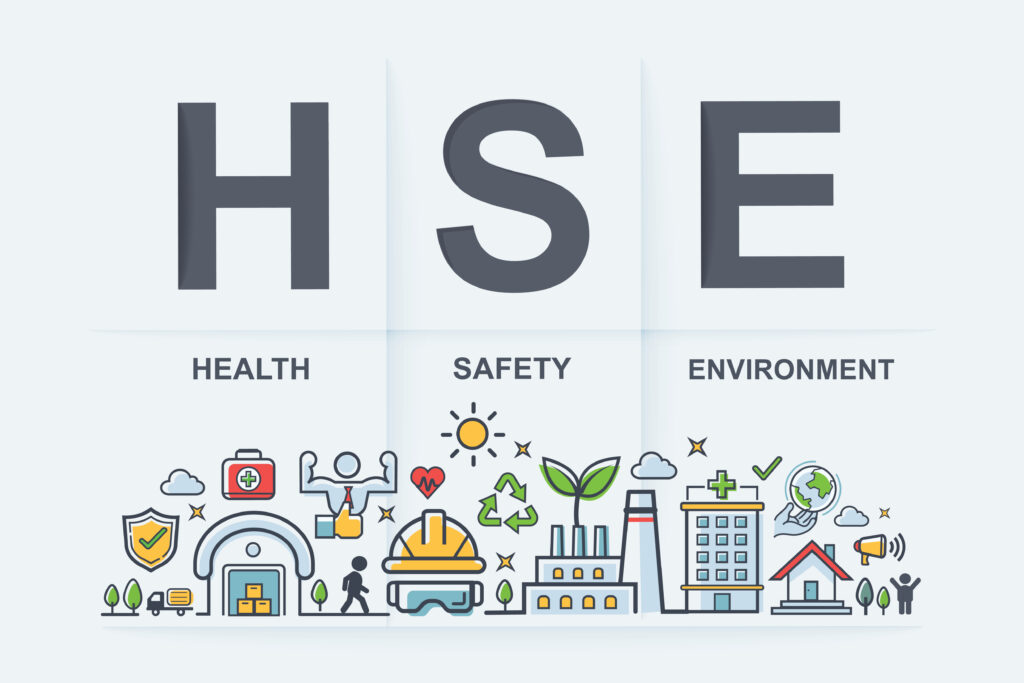Safety and Health Programs: Can you make your company safer?

Safety and Health Programs: Can you make your company safer?
No one wants an unsafe work environment. But unsafe or hazardous spots in your environment must first be reported before they can be corrected. That takes cooperation from all employees, including those reluctant to blow the whistle.
In 2004, more than 6 million work-related illnesses and work place injuries occurred in America. The biggest culprit is repetitive stress or motion injury, often requiring surgery that can keep a worker grounded for weeks. Workers’ compensation rates are increasing. Insurance companies will decline coverage to employers with high accident rates.
57% of OSHA inspections were construction related and another 22% were in manufacturing.
OSHA reports that 32% of work-related injuries occur in goods-producing industries and 68% are in services industries. The latter figure shows that services industries outnumber manufacturing, but it also shows service industries are not free of accidents.
In FY04, OSHA’s inspections, regardless of reason or industry, numbered nearly 40,000. With that level of aggressive enforcement, zero accident rates are imperative.
According to OSHA, participants in its Voluntary Protection Programs are saving millions each year because their injury and illness rates are more than 50 percent below the averages for their industries. And according to the Liberty Mutual Research Institute for Safety, every $1 invested in safety yields between $3 and $6 in savings.
Chronic under-estimates – does your company track all costs?
Safety and health professionals know that reducing the risk of accidents and illnesses can greatly reduce insurance costs. Yet most businesses miscalculate the total cost of accidents – costs beyond insurance. Unfortunately, such miscalculation leaves management uninformed and, thus, more likely to question the cost of safety and health programs.
One analyst separates direct costs from indirect costs. Direct costs are related to specific incidents and are conspicuous and easy to track, e.g. insurance and first aid supplies. Indirect costs, however, involve non-cash resources that are less tangible and conspicuous, e.g. legal counsel, human resource department time, and retraining.
A matrix outlines the total cost impact, including eight direct costs and thirteen indirect costs — 21 distinct costs that arise from each safety or health incident. Safety management programs should keep track of all 21 costs.
“Organizations are beginning to realize that safety pays tremendous dividends in terms of lower workers’ compensation and insurance costs, as well as improved employee productivity, morale, and retention,” said Alan C McMillan, president and CEO of the National Safety Council, in a recent Newsweek supplement.
Changing how employees think about the workplace – could you be safer?
Safety managers – whether full time or wearing safety as a second hat – can change unsafe work practices. A well-planned safety program can turn even a part-time safety manager into management’s new fast-tract hero.
Many companies’ safety programs are motivating employees to be so safety conscious that accidents are reduced to near zero. Such benefits are attainable through a systemic, company-wide program that grabs employees’ attention and changes their behavior for the long-term. But employees must view the safety program as both fun and worth their effort.> All this requires that “best practices” working elsewhere be implemented to avoid common safety program pitfalls.
“Safety performance is a critical leading indicator of the overall quality and competence of an organization,” said ExxonMobil senior vice president Ed Galante in the same Newsweek supplement. “It has been our experience that a disciplined approach to improving safety performance benefits all aspects of our operations. Our focus on safety has also helped us achieve lower costs, better flexibility, and higher plant utilization, all contributing to the bottom line.”
“Whether your employee sustained an injury at work or at home, the …employee is not at work,” said Liberty Mutual president and CEO Edmund F. Kelly in Newsweek. “If you support safe behavior as the culture at work, it will most likely become part of the culture at home.”
How good safety and health programs work – can your company do it?
Good business leaders understand human nature, care about each worker’s well-being, and recognize that a company’s employees are its greatest asset,” McMillan said. “For them, employee safety is non-negotiable, uncompromising, permanent.”
But in our competitive and frantic global marketplace, the safety and health issue is not typically at the top of corporate concerns. Effective safety programs cannot rely solely on safety signs. As one expert on safety programs says, “The key to success is execution.” Just focusing on the positive – let’s all be safe – can boost company morale and spell program success.
Successful safety programs focus on behaviors – what people must do to be safe. Rewards should be positioned as management’s expression of appreciation to workers for being safe. Rewards should focus on successes and should be issued immediately to maximize reinforcement of the behavior. Rewards with some showcase value work better than rewards that employees pocket or put away.
Such behaviors include one employee coaching another about a specific safe practice, or daily notices and reminders about upcoming situations that may need a heads-up. Such behaviors include safety audits of specific environments to measure progress toward objectives. But the reporting of near misses must also be a targeted and encouraged behavior.
All safety programs must have management front and center as the sponsors of the campaign. Such programs work when employees see their supervisors and top management as serious about safety, and when management views employees as the key players on the safety team. After all, the employees can probably list countless safety concerns with little provocation. The question: why aren’t they coming forward with the list? Not only may there be no incentive for them to do so, they may also be scared to cite safety problems. This reluctance is often the biggest hurdle to changing the workplace safety culture for the better.
How safety programs go wrong – Are these too familiar?
A faulty definition of safety:
Organizations that define safety as loss prevention are not serious about safety. Safety signs alone will not work. The culture must change, not the signage, and the focus must be on achievement and success, not losses and costs. Accidents can no longer be seen as acts of God; they are a breakdown of the safety system.
No teamwork:
An effective safety and health program is a three-legged stool: employees, their supervisors, and management. But take one leg out and the program collapses. Proactive participation is needed all around. Each member of the team is motivated to change the culture toward zero tolerance.
Unintended results:
Programs that focus merely on accident free days may actually discourage incident reporting, leaving unsafe conditions to prevail unchecked. Such incentives can infect employee morale with the notion that management cares more about OSHA reports rather than real safety.
Poorly constructed objectives:
Safety programs that have no clear objectives cannot work well because employees do not know what is expected of them. What’s more, the safety manager cannot measure progress if no benchmark goals and objectives are established at the beginning. According to the American Society of Safety Engineers, the greatest problem with safety programs is measurement.
When money doesn’t talk:
Monetary rewards are not effective. Employees subconsciously perceive it as a payoff for being safe.
Safety program successes around the country – Could these ideas work for you?
Successful safety programs are using unique incentives to help change the workplace culture:
Accumulated points used for merchandise redemption in an incentive catalog
Achievement cards that, once filled, can be redeemed for rewards
Management randomly calls employees with safety questions. Correct answers earned points toward merchandise.
Some case histories – Could you join this list?
Oil rig safety is essential to Shell Western. A safety program consultant helped the crew change traditional thinking with The Plus System, an incentive program that set new compliance standards for safe workplace ‘critical behaviors.’ Employees were rewarded Achievement Cards for adopting safe practices.
Plastic products manufacturer Steere Enterprises Inc. significantly dropped its annual $350,000 workers’ compensation premium. Employees were thoroughly briefed on the programs progress with lunchroom safety scorecards, pay-stuffers, safety audits, and other reminders. Employees were provided with Achievement Cards each time they exhibited a safe behavior practice over a six month time period.
Property management firm Key Property Services assigned field office personnel to study all aspects of safety for six months. Employees received a checklist of safe practices and earned ‘Safe Bucks’ (A Cards) redeemable for merchandise from an incentive catalog.
How to get started
Safety programs, as mentioned, need balance to be effective. Poorly designed safety programs can prompt employees to hide accidents. The psychology of motivation is complex and a rich body of corporate ‘best practices’ is available. Starting without such knowledge will almost surely lead to pitfalls that could have been avoided.
But starting from scratch isn’t necessary. A safety program professional can show you how to set up a program nearly free of administrative hassles and record keeping.
For more information contact:
Bob Dawson, CITE
Director
The Business Group, Inc.
(916) 415-1384
www.businessgroupinc.com
We hope you found this article about “Safety and Health Programs: Can you make your company safer?” helpful. If you have questions or need expert tax or family office advice that’s refreshingly objective (we never sell investments), please contact us or visit our Family office page or our website at www.GROCO.com. Unfortunately, we no longer give advice to other tax professionals gratis.
To receive our free newsletter, contact us here.
Subscribe to our YouTube Channel for more updates.

Alan Olsen, is the Host of the American Dreams Show and the Managing Partner of GROCO.com. GROCO is a premier family office and tax advisory firm located in the San Francisco Bay area serving clients all over the world.
Alan L. Olsen, CPA, Wikipedia Bio

GROCO.com is a proud sponsor of The American Dreams Show.

The American Dreams show was the brainchild of Alan Olsen, CPA, MBA. It was originally created to fill a specific need; often inexperienced entrepreneurs lacked basic information about raising capital and how to successfully start a business.
Alan sincerely wanted to respond to the many requests from aspiring entrepreneurs asking for the information and introductions they needed. But he had to find a way to help in which his venture capital clients and friends would not mind.
The American Dreams show became the solution, first as a radio show and now with YouTube videos as well. Always respectful of interview guest’s time, he’s able to give access to individuals information and inspiration previously inaccessible to the first-time entrepreneurs who need it most.
They can listen to venture capitalists and successful business people explain first-hand, how they got to where they are, how to start a company, how to overcome challenges, how they see the future evolving, opportunities, work-life balance and so much more..
American Dreams discusses many topics from some of the world’s most successful individuals about their secrets to life’s success. Topics from guest have included:
Creating purpose in life / Building a foundation for their life / Solving problems / Finding fulfillment through philanthropy and service / Becoming self-reliant / Enhancing effective leadership / Balancing family and work…

MyPaths.com (Also sponsored by GROCO) provides free access to content and world-class entrepreneurs, influencers and thought leaders’ personal success stories. To help you find your path in life to true, sustainable success & happiness. It’s mission statement:
In an increasingly complex and difficult world, we hope to help you find your personal path in life and build a strong foundation by learning how others found success and happiness. True and sustainable success and happiness are different for each one of us but possible, often despite significant challenges.
Our mission at MyPaths.com is to provide resources and firsthand accounts of how others found their paths in life, so you can do the same.
Mark Lutz: A Lifelong Mission to End Extreme Poverty
When Mark Lutz speaks about eradicating extreme poverty, his passion emanates from a lifetime of service and firsthand experiences around the world. Lutz, Senior Vice President of Global Philanthropy at Opportunity International, has spent more than four decades raising funds for missions and microfinance—transforming countless lives in the process. A Childhood Shaped by Apartheid Born…
Aaron Manoucheri: Building a Multi Generation Legacy in Real Estate
Aaron Manoucheri, a third-generation real estate investor and partner at Manoucheri Brothers LLC, understands the delicate balance between tradition and innovation in the family business. In a recent interview on American Dreams, he shared his journey, philosophy, and insights on navigating the ever-changing real estate landscape while maintaining a deep connection to his roots. A Legacy…
Combining Profits with Purpose: A New Era of Impact Investing
A Panel Discussion with Peter Borish, Linda Horner & Dr. Kal Mentak In an era where traditional philanthropy and capitalism often seem at odds, a new wave of thinking is reshaping the landscape—one that integrates financial success with meaningful social impact. This was the central theme of a compelling panel discussion featuring Peter Borish, Linda…
The AI Revolution: Avoiding a Future Controlled by the Few
Artificial Intelligence (AI) is at an inflection point. While most discussions center around the potential and risks of AI, Aldo Carrascoso, CEO and Co-Founder of Vivum AI, offers a different perspective—AI is at its own “War of Currents” moment, much like the battle between AC and DC electricity in the early 20th century. In a…




